Sue Bailey has had her own pattern making business for 19 years, and prior to that, she worked in the apparel trade for 17 years. “What a great industry it is to be in,” she said. “Every day is different; every season is different. The work is always interesting, and there are some fantastic people supporting it.” Based in the Waikato, the area once held many manufacturing plants. Bailey said everyone knew each other and all worked and supported each other. “Now there is one Waikato manufacturer left. It’s a sign of the times, every recession that hits New Zealand hits our trade hard.” Bailey has seen it happen many times over the years and said it’s been sad to see some great companies shut their doors.
Pattern Potentials’ main customer base is New Zealand designers making their ranges locally. From Bailey’s experience, to make in New Zealand, you need to be a top end designer or have a niche product to survive. “In my business, I send out patterns and makers daily to cutters and manufacturers, mostly Auckland-based. Last month I spent two days in Auckland visiting those cutters and manufacturers,” she said. “What a fantastic two days, so nice to put faces to names and to meet such hard working passionate people that all strive towards the cause.” During her visit, she noticed the struggle that some of the cutters and manufacturers were up against. “Firstly, the huge cost of leases and rent. Another hurdle for many in the trade is the way this industry works so full on seasonally. For part of the year you need as many staff as you can get your hands on and work extra hours to get the work through,” Bailey explained. “The other part of the year you struggle to keep all of your workers busy and paid. For some, restructuring their business to work with this means keeping a small stable workforce that you can run all year round and only take on the work that you can put through with your staffing in the busy times.”
Although her visits were very positive, Bailey added a lot of companies had discarded speciality equipment in the corner. Machinery that was once worth a lot, now worth more to sell as scrap metal. “We no longer have the need for all of the machinery and in some cases, no longer have the skilled people to use the more specialised ones.”
Across the board, New Zealand Made is notably completed to a very high standard, whether it’s a wool coat or a chiffon blouse. “The passion is there, the determination and fight is there, we need to support these people to continue with their great work for us all before it is too late.”
Even though Bailey doesn’t believe New Zealand apparel manufacturing will get any bigger, she really wouldn’t like to see it get any smaller. The local industry needs to work together to keep New Zealand made alive and to create opportunities for designers and retailers to utilise our local talent. “Is it possible for designers and retailers to spread the seasons? Can design institutes teach more about the manufacturing process, rather than just design, and producing graduates who are mostly equipped to be garment technicians, writing specs for offshore manufacturers? The trade has many exciting career prospects; I think students need to be a part of that process to be reminded what it truly encompasses and how exciting it can be. Let’s keep New Zealand manufacturing alive. Let’s keep our workforce trained and skilled before it is too late.”
For more information, visit www.patternpotentials.co.nz.






